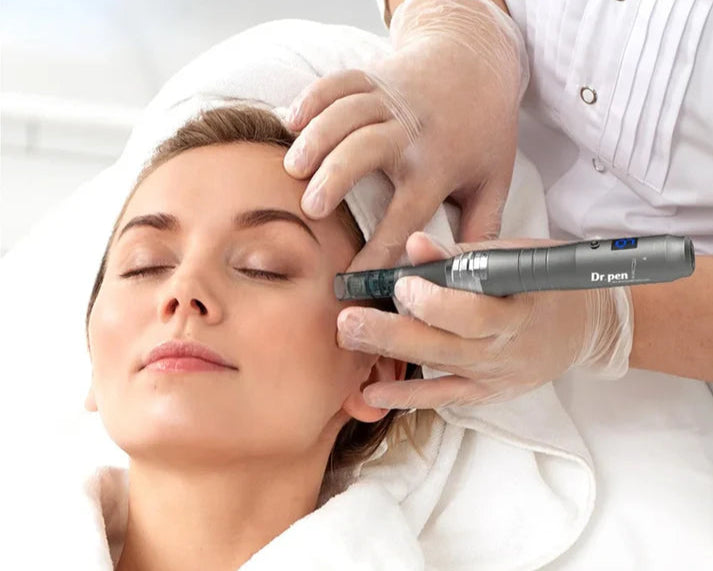Eczema, a common skin condition characterized by inflammation, redness, itching, and dryness, affects millions of people worldwide. This chronic condition can significantly impact one's quality of life, as the relentless cycle of flare-ups and remissions can be both physically uncomfortable and emotionally distressing. Traditional treatments often involve a combination of topical creams, oral medications, and lifestyle adjustments. However, as the quest for effective and accessible therapies continues, alternative methods like microneedling have emerged, piquing the interest of both patients and healthcare providers.

Microneedling, also known as collagen induction therapy, involves the use of a device equipped with fine needles to create controlled micro-injuries on the skin's surface. This process is believed to stimulate the body's natural healing response, leading to increased collagen and elastin production, improved skin texture, and reduced signs of aging. But can this technique, typically associated with anti-aging and scar treatment, also offer relief to those suffering from eczema?
To delve into this question, it's essential to understand the underlying mechanisms of eczema and how microneedling works. Eczema is thought to result from a combination of genetic factors, immune system dysfunction, and environmental triggers. The skin barrier, which acts as a protective shield against external irritants, becomes compromised in individuals with eczema. This leads to moisture loss, increased sensitivity, and an heightened immune response, manifesting as the characteristic symptoms of the condition.
Microneedling pens, a popular tool in the realm of skincare, consist of a handheld device with a disposable tip containing numerous tiny needles. When used correctly, these pens can penetrate the skin at a depth ranging from 0.5 to 2.5 millimeters, depending on the area being treated and the desired outcome. The controlled injury caused by the needles triggers a cascade of healing processes, including the release of growth factors and cytokines, which promote tissue repair and regeneration.
One of the potential benefits of microneedling for eczema sufferers lies in its ability to enhance the skin barrier function. By stimulating collagen and elastin synthesis, microneedling may help strengthen the skin's structural integrity, reducing moisture loss and improving its overall resilience. A stronger skin barrier could potentially lead to fewer flare-ups and milder symptoms when exposures to triggers do occur.
Moreover, microneedling has been shown to modulate the immune response in the skin. Studies suggest that the micro-injuries created by the needles can shift the immune system's activity from an inflammatory state to a more regulatory one. This immune modulation could be particularly beneficial for eczema, where an overactive immune response plays a central role in the development of symptoms.
Another avenue through which microneedling might aid eczema is by enhancing the absorption of topical treatments. The microchannels created by the needles allow topical medications, moisturizers, and other therapeutic agents to penetrate deeper into the skin, potentially increasing their effectiveness. This could mean that individuals with eczema might see better results from their usual topical creams and ointments when used in conjunction with microneedling.
Despite these promising theoretical benefits, it's crucial to approach microneedling for eczema with caution. The skin of someone with eczema is often more sensitive and prone to irritation than that of someone without the condition. Therefore, the risk of adverse reactions, such as exacerbation of symptoms, infection, or pigmentation changes, must be carefully considered.
Before undergoing microneedling, it's advisable for individuals with eczema to consult with a dermatologist or a qualified skincare professional who has experience treating eczema. They can assess the severity of the condition, identify any potential contraindications, and tailor the treatment plan accordingly. It's also important to ensure that the microneedling pen used is sterile and that the procedure is performed in a clean, controlled environment to minimize the risk of infection.
In addition to professional guidance, proper aftercare is essential to maximize the benefits of microneedling and minimize potential risks. This typically involves avoiding sun exposure, using gentle skincare products, and keeping the treated area hydrated and protected.
While research specifically focusing on microneedling for eczema is limited, anecdotal evidence and case studies suggest that some individuals have experienced improvement in their symptoms after undergoing the procedure. However, it's important to note that results can vary widely from person to person, and what works for one individual may not be effective for another.
Furthermore, microneedling should be viewed as a complementary therapy rather than a standalone treatment for eczema. It's most likely to be beneficial when used in conjunction with other management strategies, such as avoiding known triggers, maintaining a consistent skincare routine, and following medical advice.
In conclusion, microneedling pens hold some promise as a potential adjunctive therapy for eczema. By strengthening the skin barrier, modulating the immune response, and enhancing the absorption of topical treatments, microneedling may help alleviate symptoms and improve the overall quality of life for those with this chronic condition. However, due to the sensitive nature of eczema-prone skin, it's crucial to approach microneedling with caution, under the guidance of a qualified professional, and with a thorough understanding of the associated risks and benefits. As research in this area continues to evolve, microneedling may emerge as a valuable addition to the array of tools available for managing eczema.

Share:
How to Incorporate Microneedling Pen into Your Skincare Routine
Can You Use a Microneedling Pen on Your Lips?